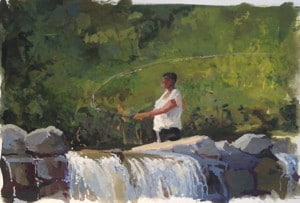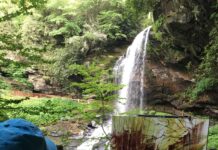by Edward Bell
The Philadelphia Sketch Club, one of the oldest professional art clubs in the country, has held its First Annual Summer Urban Plein Air Event, and it now joins many other major metropolitan areas in hosting a local plein air event on an annual basis. For this year’s event the boundaries of the competition were set on the east-west margins of Center City or between the Delaware and Schuylkill Rivers. Contestants painted from May till mid-July before submitting work. This first event was a juried competition, but future events will be non-juried shows for plein air work completed in the preceding year. Rather than choose placements, the judges decided to give three Best of Show awards to the finalists: Edward Bell for “Water Dancers,” Mateus Costa for “Under 95,” and Sarah Baptist for “Jackson Avenue.” In keeping with the club’s mission to provide a community for visual artists, appreciation for the visual arts and visual arts education, submission to future shows will be open to the public. Additional details will be announced in the spring of 2019.
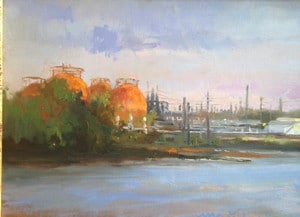
Philadelphia has long been a center for the fine arts and has a deep artistic tradition. Many of the leading colonial painters included Benjamin West, Gilbert Stuart, Thomas Sully, and Charles Wilson Peale,who studied or worked abroad and brought their expertise back to Philadelphia. Local examples of plein air painting date back to the early 19th century. Thomas Doughty, considered the first native-born landscape painter, painted the Delaware Water Gap, in 1820. Following the foundation of the Pennsylvania Academy of Fine Art (PAFA) in 1805 by Charles Wilson Peale, naturalist, scientist and painter, and William Rush, sculptor, academy students learned direct painting as practiced and taught by PAFA instructors and PSC members Thomas Eakins and particularly, Thomas Anshutz.
Although field sketching in oil was practiced in the 18th century by artists like Courbet, direct painting en plein air was primarily a watercolor endeavor until the invention of oil paint packaged in tubes around 1840. Taking John Constable’s lead, plein air artists began to take on landscape painting and show “light – dews – breezes – bloom – and freshness” in their work. In Philadelphia, by way of the many schools and influential practitioners, that example produced a distinctly American style.
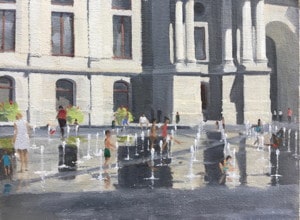
Since its founding in 1860, the Philadelphia Sketch Club has been an essential element in the artistic and cultural mix of Philadelphia. Members of the club taught and painted in regional schools and influenced a number of painters important to American art. The New Hope Impressionists and the Ashcan artists included members of the club and graduates of PAFA. Club members such as Daniel Garber and Edward Redfield were important teachers and seminal figures in art. Edward Redfield, perhaps more than others, is recognized as the American who helped bring plein air Impressionism to America. Like his European counterparts, he was interested in the effects of light in the landscape, but he developed a plein air style that was independent of their precedent.
Along with William Lathrop, Redfield relocated to and began painting landscapes in the picturesque area of Bucks County near New Hope, PA, around 1898. They attracted to the area a group of artists, shortly to include W.E. Schofield, George Sotter, Henry Snell, and Daniel Garber. The New Hope group, which became known as the Pennsylvania Impressionists, grew and developed a style that illustrated distinctly American themes such as the nobility of work and the “search for the real,” as Pissarro would have said. Their landscapes showed light and freshness of color and an emphasis on careful draftsmanship as taught by PAFA. Redfield was renowned for the lengths that he was willing to go to, to complete work in the field. He produced many snowy landscapes and is said to have lashed his canvases to trees during winter storms to finish a painting. He is also said to be the most awarded American artist of his time, with the possible exception of John Singer Sargent.
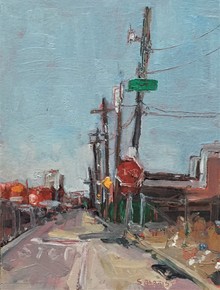
The Club also attracted members who worked in Philadelphia’s often robust media markets. Graphic artists, illustrators, photographers, naturalists, and other artists gathered here. Thomas Moran, N.C. Wyeth, and H.C. Christy were members. The Club provided studio space and workshops of many types and a social setting for its all-male membership. That historic clubhouse, on a quaint cobblestone street, includes a dining room, a gallery with a pool table, a meeting room ringed with 44 of Thomas Anshutz’s portraits of members, a skylit studio, and a place were members could keep a bottle, relax, and socialize. Until recently members were given keys and allowed to come and go at will. A sister club, the Plastic Club, opened down the street and was run by and for women in the arts.
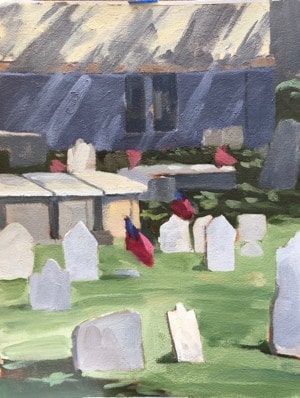
Both clubs, the Sketch Club and the Plastic Club, still exist much as they were one hundred and fifty-plus years ago and are open to members and the public for study and workshops. Workshops are available most days and evenings for a minimum fee. Internships for local art students are also available. For artists and laypersons interested in traditional and figure-based work, nude and costume, the Philadelphia Sketch Club is an accessible, affordable, and charming amenity in this city.

